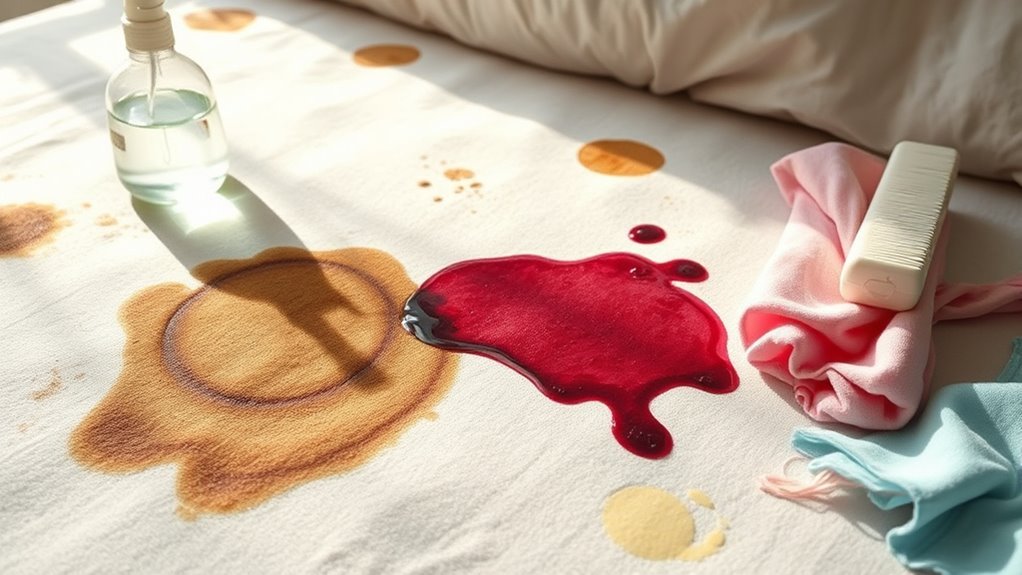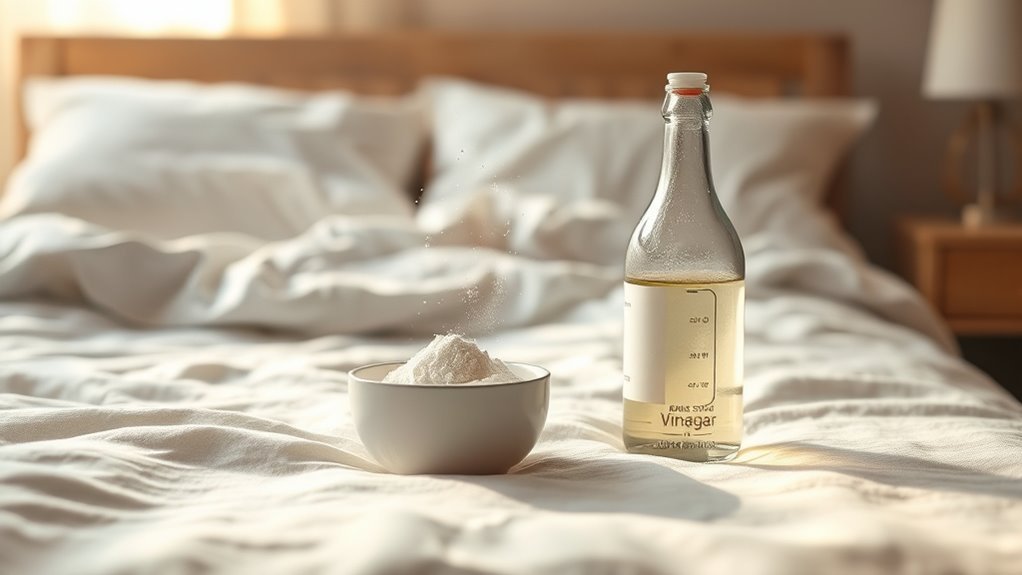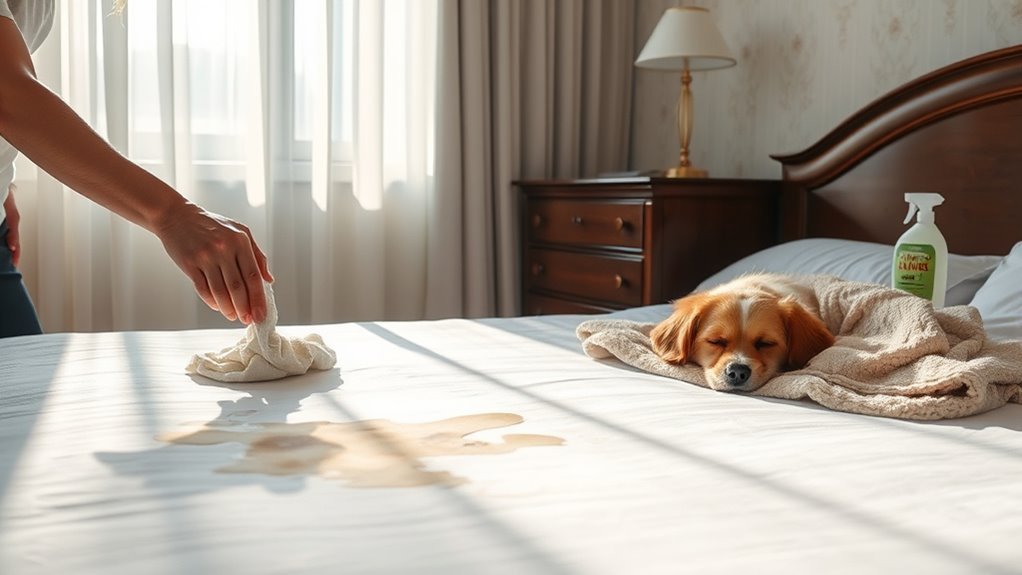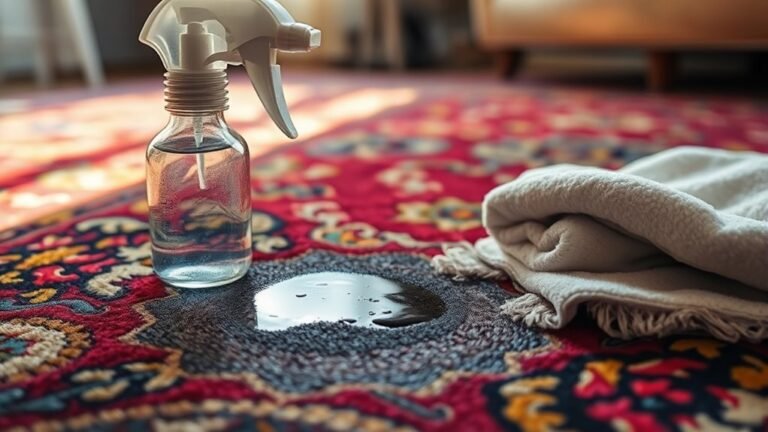Removing Stains From Mattress Effectively
To remove stains from your mattress effectively, start by identifying the stain type—dark spots often come from spills, sweat leaves yellow marks, and blood stains are reddish-brown. Use baking soda and vinegar to lift most stains: sprinkle baking soda, spray vinegar, let it fizz, then blot and vacuum. For blood or sweat, try cold water or hydrogen peroxide. Don’t forget to dry thoroughly to prevent odors. There are more useful tips and tricks to keep your mattress fresh and stain-free.
Identifying Different Types of Mattress Stains

How do you know what kind of stain you’re dealing with on your mattress? Identifying stains is the first step toward reclaiming your sleep sanctuary. You might spot dark patches from spilled drinks or light yellow marks from sweat. Blood stains often appear reddish-brown, while urine leaves a distinct odor and discoloration. Each stain type demands a tailored approach, so recognizing them empowers you to act confidently and swiftly. When you understand the characteristics of common mattress stains, you break free from uncertainty and take control of your cleaning process. Pinpointing the exact stain type helps you avoid guesswork, saving time and effort while preserving your mattress. With this knowledge, you’re ready to tackle stains head-on and enjoy a fresh, clean bed.
Essential Cleaning Supplies for Mattress Stains
To tackle mattress stains effectively, you’ll need the right cleaning tools on hand. Essential items include a spray bottle, clean cloths, and a soft brush to gently lift stains. Picking the best stain removal agents, like enzyme cleaners or mild detergents, will make a big difference in your results.
Must-Have Cleaning Tools
A few essential cleaning tools can make removing mattress stains much easier and more effective. You’ll want a good vacuum cleaner with a hose attachment to lift dirt and dust, setting the stage for deep mattress cleaning. Keep microfiber cloths handy; they’re perfect for blotting stains without spreading them. A spray bottle helps you apply cleaning solutions evenly, vital for stain prevention and treatment. Don’t forget rubber gloves to protect your hands while tackling messes. A soft-bristled brush can gently loosen tough stains without damaging your mattress fibers. Having these tools ready gives you the freedom to act quickly and confidently, preserving your mattress’s freshness and extending its life without hassle.
Best Stain Removal Agents
With the right tools in hand, you’re set to tackle mattress stains more effectively by choosing the best stain removal agents. Start with enzyme cleaners—they’re powerful at breaking down organic stains like sweat, blood, or food. These cleaners work deep, freeing you from stubborn marks without harsh scrubbing. Next, consider stain repellents; applying them after cleaning helps create a protective barrier, so spills don’t sink in. This means less stress and more freedom from frequent deep cleans. Always pick agents safe for your mattress fabric to avoid damage. By combining enzyme cleaners for removal and stain repellents for protection, you simplify your routine and keep your mattress fresh longer, letting you enjoy a cleaner, more comfortable space without hassle.
Using Baking Soda and Vinegar to Lift Stains

Although tackling mattress stains might seem challenging, using baking soda and vinegar can make the process surprisingly simple and effective. This natural duo offers a powerful stain lifting solution without harsh chemicals, giving you freedom to clean safely and efficiently.
Here’s how you can put the baking soda and vinegar mixture to work:
- Sprinkle baking soda generously over the stain to absorb moisture and loosen dirt.
- Spray or dab a vinegar mixture onto the baking soda; it will fizz, helping break down the stain.
- Let it sit for 30 minutes, then blot with a clean cloth and vacuum the residue.
This method frees you from stubborn stains, restoring your mattress’s freshness with ease.
Treating Blood and Sweat Stains Effectively
When it comes to blood and sweat stains, acting quickly is key to preventing them from setting in. You’ll want to use the right techniques to break down these stubborn marks without damaging your mattress. Let’s explore how to treat these stains effectively and keep your mattress fresh.
Blood Stain Removal
If you’ve ever dealt with blood or sweat stains on your mattress, you know how stubborn they can be. Blood stain types vary, from fresh drops to dried spots, requiring different approaches. To tackle blood stains effectively and enjoy stain freedom, try these steps:
- Act quickly—fresh blood washes out easier with cold water. Avoid hot water; it sets stains.
- Use a mild detergent or hydrogen peroxide on dried spots, applying gently to preserve fabric.
- Always blot, never rub, to prevent spreading.
For blood stain prevention, consider mattress protectors and prompt cleaning after any accident. This way, you keep your mattress fresh and free, embracing the freedom of a clean, comfortable bed.
Sweat Stain Treatment
Sweat stains can be just as challenging as blood stains, but with the right approach, you can remove them effectively. Since sweat absorption varies with mattress materials, start by identifying yours. Use a gentle mix of baking soda, water, and vinegar to break down the stain without damaging the fabric. Blot, don’t rub, to avoid pushing the stain deeper. Air-dry completely to prevent odors.
| Feel Fresh | Sleep Freely | Live Boldly |
|---|---|---|
| Clean mattress | No stains | Peace of mind |
| Breathable fabric | Easy upkeep | Confidence |
| Sweat-free nights | Natural remedies | Freedom |
Treat your mattress with care, and reclaim your freedom from sweat stains for good.
Preventing Stain Set-In
Because stains can become permanent if left untreated, acting quickly is key to preventing set-in on your mattress. When you catch blood or sweat stains early, you maintain control over your mattress care and keep your sleeping space fresh. For effective stain prevention, try these steps:
- Blot, don’t rub: Use a clean cloth to absorb excess moisture without spreading the stain.
- Apply cold water or a gentle cleanser promptly: This helps break down proteins in blood or sweat before they set.
- Air dry completely: Ensuring your mattress dries fully stops mold and mildew, preserving its integrity.
Removing Food and Drink Spills From Mattress
Although food and drink spills on your mattress can be frustrating, acting quickly can prevent permanent stains. When you notice a food stain or drink spill, grab a clean cloth to blot the area gently—don’t rub, as that pushes the stain deeper. Next, mix a solution of mild dish soap and cold water. Lightly dab this onto the stain to break down the residue. For stubborn spots, a bit of white vinegar diluted in water can help lift the stain without harsh chemicals. After treating the area, blot it with a dry cloth to remove excess moisture. Let your mattress air dry completely before putting sheets back on. Taking these quick steps keeps your mattress fresh and stain-free, giving you the freedom to enjoy your space without worries.
Dealing With Pet Stains and Odors

Food and drink stains can be tricky, but pet stains and odors bring a different set of challenges to your mattress care routine. When dealing with pet odor removal and urine stain treatment, you want methods that work fast and effectively. Here’s how to tackle it:
- Blot Immediately – Use paper towels to soak up as much urine as possible without rubbing, preventing the stain from setting.
- Apply Enzymatic Cleaner – These cleaners break down urine proteins, eliminating odors and stains at the source.
- Air Dry Thoroughly – Let your mattress dry completely in a well-ventilated space to avoid mold and lingering smells.
This approach keeps your mattress fresh and free, so you can enjoy restful nights without pet-related worries.
Preventative Measures to Avoid Future Stains
If you want to keep your mattress looking and smelling fresh, taking preventative measures is key. Start by investing in quality mattress protectors—they act as a barrier against spills, sweat, and accidental stains, giving you peace of mind and freedom from constant worry. Alongside this, regular maintenance is essential. Make it a habit to vacuum your mattress weekly to remove dust and allergens that can settle over time. Avoid eating or drinking in bed to minimize risks, and air out your mattress occasionally to keep it dry and fresh. By combining mattress protectors with consistent care, you’ll extend your mattress’s lifespan and enjoy a clean, comfortable space without feeling tied down by constant cleaning hassles.
Drying and Maintaining a Clean Mattress After Cleaning
Taking steps to prevent stains is just one part of mattress care; knowing how to properly dry and maintain your mattress after cleaning keeps it in top shape longer. Effective mattress drying prevents mold and odors, while regular mattress maintenance preserves comfort and hygiene.
Proper drying and maintenance after cleaning are key to preventing mold and keeping your mattress fresh and comfortable.
Here’s how you can keep your mattress fresh and dry:
- Air it out thoroughly: Open windows or use fans to speed up mattress drying after cleaning.
- Use absorbent towels: Press gently on damp spots to soak up excess moisture before air drying.
- Rotate regularly: Flip or rotate your mattress every few months to maintain even wear and extend its life.
Frequently Asked Questions
Can Mattress Stains Cause Allergies or Health Issues?
Imagine your mattress as a hidden garden where tiny, unseen guests—mattress allergens—thrive. These guests can stir up health concerns like sneezing or restless nights. If you want to breathe freely and feel truly at ease, it’s important to know these allergens might be quietly affecting you. Taking care of this secret garden helps you reclaim your freedom from discomfort and sleep soundly without worries.
How Often Should I Deep Clean My Mattress?
You should deep clean your mattress every six months to keep it fresh and healthy. Following mattress maintenance tips like vacuuming regularly and spot cleaning spills promptly helps too. Cleaning frequency recommendations suggest that if you have allergies or pets, you might want to clean more often—about every three to four months. Staying consistent with these habits gives you the freedom to enjoy a clean, comfy sleeping space without worry.
Are Mattress Cleaning Services Worth the Cost?
You might wonder if mattress cleaning services are really worth the cost. The truth is, while you can handle mattress maintenance yourself using cleaning products, professionals offer a deeper clean that’s tough to match. If you value your time and want freedom from scrubbing stains or allergens, investing in a service can be smart. It’s about balancing effort, cost, and the comfort of a fresh, healthy sleep environment.
Can UV Light Help Sanitize a Mattress?
You’re wondering if UV light can help sanitize a mattress, right? Absolutely, UV sanitization is a great tool for mattress care since it uses ultraviolet rays to kill bacteria, viruses, and dust mites without chemicals. It’s a simple way to keep your mattress fresh and free from germs, giving you more freedom from worries about allergens or pathogens. Just remember, it doesn’t replace deep cleaning but complements your routine nicely.
Is It Safe to Use Bleach on a Mattress?
Imagine pouring a harsh chemical on your mattress, the bleach seeping deep and possibly damaging mattress materials like foam or memory foam. You probably don’t want that, right? Using bleach on mattresses isn’t usually safe because it can weaken fibers and leave strong odors. Instead, you can choose bleach alternatives like baking soda or vinegar, which freshen and clean without risking harm—letting you enjoy a stain-free mattress without feeling trapped by harsh chemicals.






